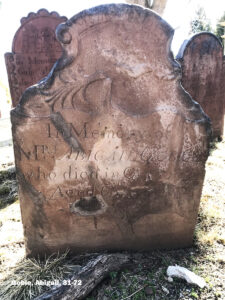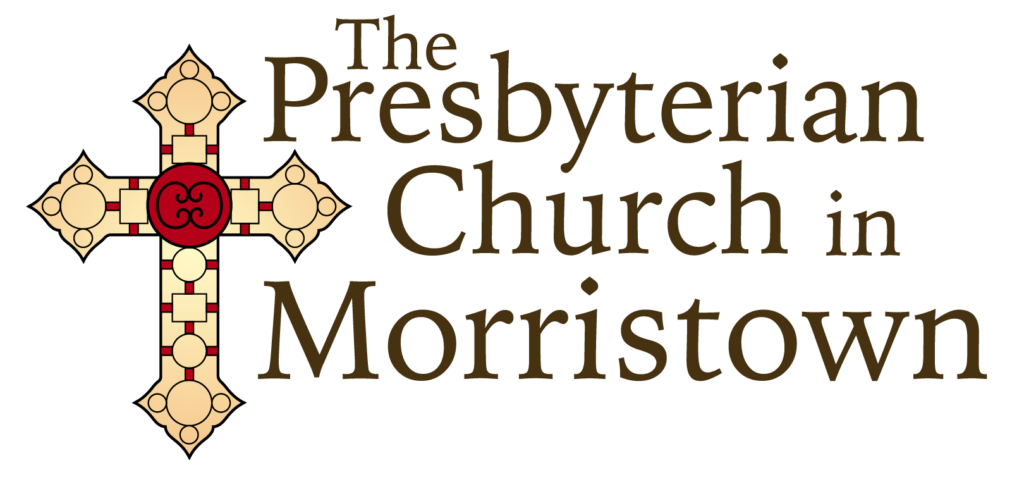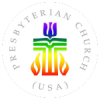Location #1
Welcome to this self-guided tour of the burying ground – the graveyard – of The Presbyterian Church in Morristown. This is the first of 5 stops that will take you through the graveyard. Look at the photo at the top of the page for each location for the view at each stop, and you will also find a tour sign nearby.
To find more information about an individual, a gravestone, or monument, use the buttons at the bottom of the tour page to link to a searchable database of individuals known to be buried here or to maps that can help you locate markers by name. With the maps you will also find links to photo albums covering all gravestones and monuments in the graveyard. For more on the history of the church click here, and for more on the history of the graveyard and record keeping click here.
Begin your self-guided tour: Along the wall about the middle of the parking lot behind the Sanctuary building
This area is the oldest section of what is the earliest known burying ground in Morristown. The oldest woman interred in the burying ground is believed to be Abigail Goble who was born about 1680. Her marker, directly in front of you, displays some of the classic stonecutter’s art common in early grave markers. Notice the hand coming from the clouds to cut down the “Tree of Life.” Although the congregation of the church did not begin forming until 1733, the earliest visible grave marker is dated 1731. That marker denotes the resting place of Martha Parson. It is located to your right, near the wall, this side of the large centograph.


As was the tradition in colonial cemeteries, early interments were with the feet of the deceased facing East. This made it a simple matter for the deceased to rise up to meet the angel Gabriel, who would be arriving from the East. This resulted in earlier grave markers having a North-South orientation, the angle of the layout before you. Other than that, early interments were somewhat haphazard. In some cases, they were in whatever place the family and friends of the deceased pointed out. One grave was encroached upon to make room for another, which in turn was disturbed to make room for a third. The remains of strangers often were placed between members of the same family. In 1833, a plan to correct these practices was adopted by the Trustees of the Church. In 1855, Evergreen Cemetery opened, and the Trustees of the Church began restricting interments to families with private plots. In the years that followed, some families chose to relocate remains of loved ones to the new cemetery. In 1990 a Memorial Garden was created along the Morris Street side of the cemetery to the right of where you are standing. The Memorial Garden provides a spot for placement of cremains of loved ones.
The vast majority of grave stones found in the graveyard were placed between the 1730s and the 1850s and offer a good sample of grave stone art of their time. The earliest stones were of sandstone. This reddish brown sedimentary stone, found along the banks of New Jersey rivers was popular with local carvers because of the ease with which it could be worked. In the early 19th century, marble gained in popularity, perhaps due to the growing classical influence in the arts. Not being available locally, marble was more expensive than sandstone. It also was more difficult to carve. Both sandstone and marble have difficulty standing up to the ravages of time. Typical of some of the earliest carvings were “Death Heads” with their hollow eye sockets, square tooth grin, and angular nose. As the stark Puritain view of death, sin, and damnation softened the figures took on a more cherub-like appearance representing the ascending soul or angel and “The Hope of Resurrection.” Still later figures included other metaphoric forms, e.g., three flowers representing “The Trinity,” a shell representing “The Resurrection and Life Everlasting” and the weeping willow representing “Sorrow and Weeping With Grief.”
With that little bit of history and background, you now are ready to proceed to Location #2. You may do so by walking to your right along the wall and around the bend until you reach the gate in the fence. Take time to notice the rings embedded in the wall. They are the last evidence of the horse stables that once stood on this site. They were used to tether horses of worshippers during church services.

